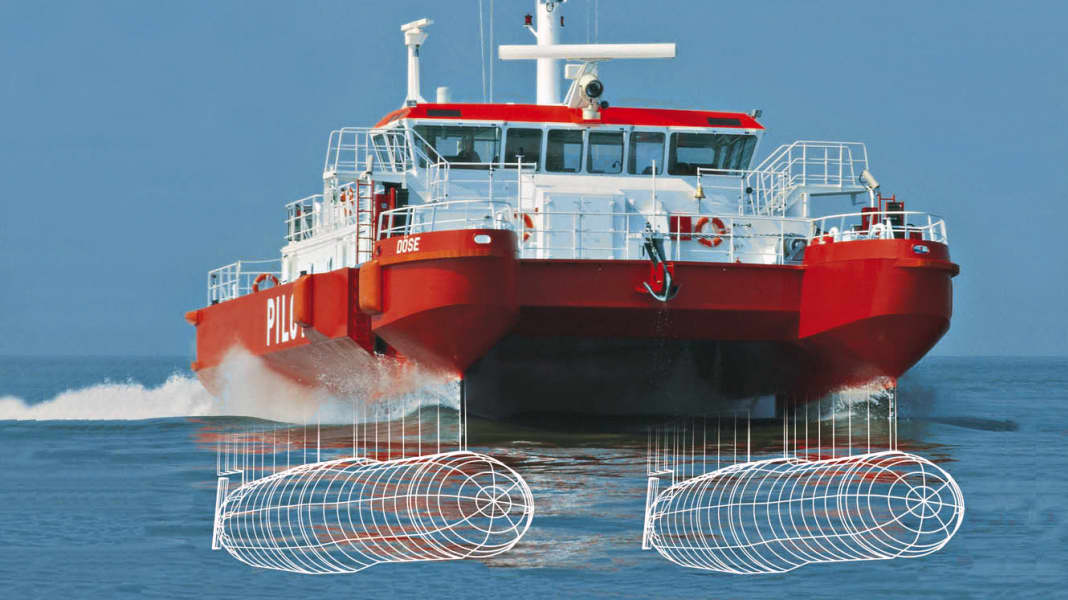
When a genuine Berliner asked me what my specialism was, I eagerly answered and mentioned hydrodynamics, adding by way of explanation that this essentially involves fluid mechanics. Well, he probably couldn't imagine too much about that either and asked: "Watt strömten bei Ihnen?" What flows or, more correctly, what is flowed around? For us as boat owners, the answer is not difficult: of course the hull of the moving ship from the water and the surface ship from the airstream. It's actually quite simple, if it weren't for the many small peculiarities and irregularities that are still being puzzled over by a wide variety of scientists in ship technology research centres.
On the other hand, this is where the special attraction lies, namely in finding the most effective solutions to problems from nature. If the flow follows the ideal body shape under water or in the air, if it moulds itself to the body, the course of the flow not only meets our aesthetic expectations, but above all the body resistance is also low. However, the respective medium has to close again somewhere, and this is not ideal. Turbulence - eddies - are unavoidable. That's why it gurgles behind the stern or flutters our flag and doesn't stand stiffly in the current like the rigid wind direction indicator.
Propulsion is generated by the fish through tail movements, which are difficult to reproduce in technology. After all, wrigging with the rudder - which is rarely used today for propulsion - has a similar function. This is how man invented the propeller rotating around an axis, an invention that cannot be overestimated, which in turn does not exist in nature in this form, as body parts cannot be organically supplied with energy via an axis to the wheel.
However, in contrast to the relatively organised, low-loss outflow of the fishtail, the propeller sucks the water into a current tube and discharges it in a wildly turbulent, spiral-shaped wake. In the process, more than 30 % of the power input is usually lost for the boat's thrust. Especially in canals, recreational skippers can feel the turbulent water far behind an inland vessel. And the rudder is usually located in this disorganised current, which is very effective due to the increased current speed, but at the same time is exposed to considerable vibrations and often causes problems due to cavitation shocks, even with propellers under higher loads.
Speaking of rudder and steering ability: I was recently sailing in the Elbe-Lübeck Canal at the prescribed low speed behind a five metre long and fairly wide planing boat and could barely see the boat lurching back and forth in the canal, even though the skipper was cranking his steering wheel wildly. The boat, which was designed for planing, lacked any guidance in the incoming current. A fin (fin) the size of a surfboard would eliminate these shortcomings. Something similar would not exist in nature.
This small example already demonstrates that the ideal flow around the boat cannot be realised. Our boats do not move deeply submerged, but on the water surface, generate waves and have to overcome an additional resistance, at least in the area of the hull speed, which often amounts to several 100 % of the other resistance components. Bioengineers also have no models in nature to fall back on. Animals that move at higher speeds on the surface of the water like a boat when partially submerged do not exist.
The 100-fold difference in density between water and air is an incontrovertible fact. The positive or negative dynamic pressure generated by the boat creates wave crests and troughs. Consequently, engineers looked for solutions to reduce the drag component. They invented the planing boat and later the hydrofoil. In both cases, dynamic buoyancy is generated, which significantly reduces the wave resistance in relation to speed. However, if the boat speed is insufficient, both types of boat fall back into the unfavourable flow state.
But solutions were also sought for the "displacer" and were found in the catamaran and - perhaps even more convincingly - in SWATH ships. SWATH stands for Small Waterplane Area Twin Hull, which is also a type of catamaran, but with very narrow waterline surfaces, while the actual hull, which is responsible for the buoyancy of the ship, lies deep below the water surface. These boats are ideal for both low speeds and high speeds.
What is the secret? The answer is: what is required is the narrowest possible waterline area or, to put it another way: a large WL length in relation to the WL width with the most ideal profile shape possible. Only then will the proportion of wave resistance remain low! For example, a flat plate flowing from the edge would have a wave resistance that is almost zero. If the displacement body remains deeply submerged, as in the SWATH boat, it largely corresponds to the ideal body in the flow described at the beginning, and the propeller also operates in the higher static pressure range when deeply submerged, which means that cavitation and controllability can be better controlled at the same time.
The exact opposite, namely a large WL width, is required for planing boats in order to generate sufficient dynamic buoyancy. Of course, there are also many pros and cons for catamarans or SWATH boats, which will not be discussed further here, but are certainly worth discussing in detail. At the very least, the boat market should consider new boat types with low power requirements across all speed ranges in the future.

